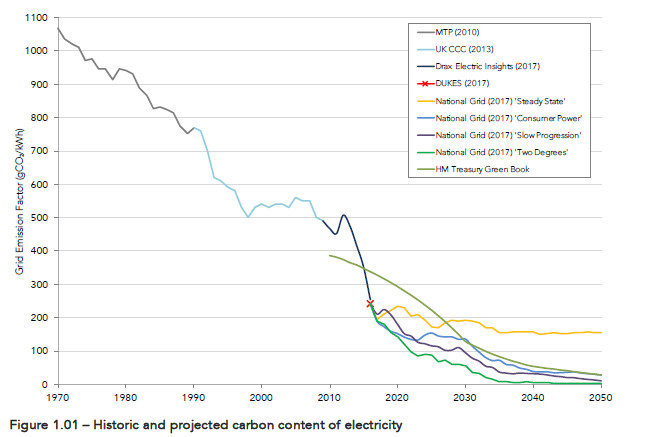Date Published: May 2022
Grid Watch
By GSHPA
Categories: News
The UK National Grid is decarbonising rapidly
As electricity generation from coal is being phased out and wind generation increases the carbon intensity of the Grid is falling steadily each year. This is good news for those who can see that the decarbonisation of heat is greatly helped by the decarbonisation of the Grid and ultimately the Electrification of Heat.
Using DEFRA data, the carbon factor of grid electricity was 495 gCO2e/kWh generated in 2014.
In 2015, the equivalent figure was 462, which represents a fall of over 6.5%.
In 2016 the figure was 412, a fall of 10.8%.
In 2017 the figure was 352, a fall of 14.6%.
In 2018 the figure was 283, a fall of 19.6%.
In 2019 the figure was 256, a fall of 9.7%.
In 2020 the figure was 233, a fall of 8.8%.
Carbon Calculator for GSHPs
Whenever the current grid carbon factor is below 215 grams of CO2 per KWh then even direct electric heating emits less carbon from the grid than a gas boiler does on site!
This app uses current grid carbon intensity – updated every half hour – and illustrates how much lower carbon emissions are now from ground source energy than heating systems based on combustion.
The CO2 issued by a heat pump powered from green electricity is, of course, zero. This CO2 emissions calculator, sponsored by Geoscience, shows the CO2 issued if your ground source heat pump uses grid electricity.
The values for ground source heat pumps using grid electricity have fallen rapidly as grid electricity generation from coal has fallen, and generation from renewable power technologies has risen.
GridWatch by Country and Area of the UK
To see variations in CO2 emissions in different parts of the UK then click on the relevant red labels on the right.
GridWatch
For those with access to a PC, the GridWatch website tracks the source of electricity generation on the UK National Grid and displays it graphically – with updates every five minutes. Expand your window to a wide screen and hover over the guages for useful further information.
Take a look also at the GridWatch Carbon data for France where you will sometimes see that France generates more than 100% of its needs from carbon free sources, and exports the surplus to other nations through “interconnects”.
Air quality is also a key driver
A significant benefit of heat pumps over conventional gas boilers is that there is no combustion involved (combustion of gas emits oxides of nitrogen). Beside the direct advantages (safety), technical advantages (no need for flues) this is very beneficial for cities like London with poor levels of air quality.
Alternative forms of low carbon heating
Alternative forms of low carbon heating have also been considered including direct electric heating, which has a significantly higher running cost; and the burning of hydrogen which emits no CO2 at the point of combustion.
However, upgrading the gas grid to contain very small hydrogen molecules would incur a huge national cost and upgrading all the boilers to burn hydrogen would also be a significant task. Production of hydrogen by steam reformation emits large volumes of CO2 which would require the development of economic Carbon Capture and Storage to achieve carbon neutrality.
Hydrogen can also be derived from electrolysis powered by renewable electricity, although the overall efficiency would be less than 70% before accounting for distribution losses, compared to an efficiency of well over 300% for a typical ground source heat pump.
It is clear that the only practical route to heating without CO2 emissions is to avoid combustion. The alternative is to use heat transfer: which means using heat pumps. There is no need to search for esoteric alternatives when tried-and-tested heat pumps are available now.
Please click here to access GridWatch.

